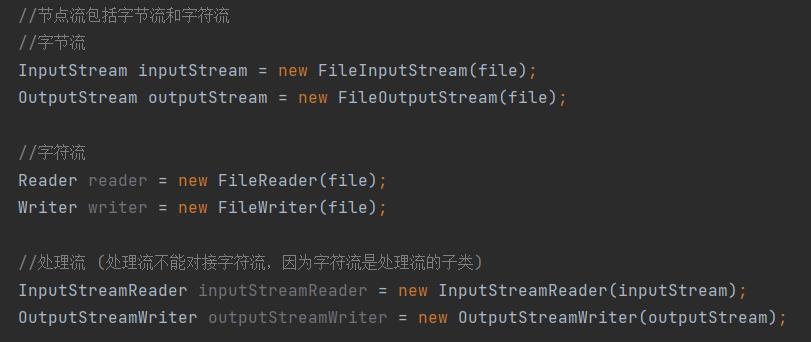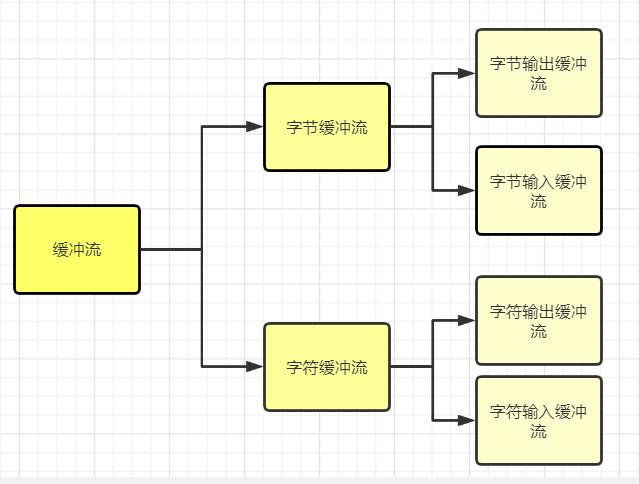java流总结
Posted 若曦`
tags:
篇首语:本文由小常识网(cha138.com)小编为大家整理,主要介绍了java流总结相关的知识,希望对你有一定的参考价值。
1. java流的分类
按方向分:输入流+输出流(IO流)
按单位分:字节流+字符流
(字节流是指每次处理数据以字节为单位,字符流是以字符为单位)
按功能分:节点流(字节流) + 处理流(对节点流进行处理,生成其他类型的流)
2. File 类
java.io.File,使用该类的构造函数就可以创建文件对象,将硬盘中的一个具体的文件以 Java 对象的形式来表示
| 方法 | 描述 |
|---|---|
| public File(String pathname) | 根据路径创建对象 |
| public String getName() | 获取文件名 |
| public String getParent() | 获取文件所在的目录 |
| public File getParentFile() | 获取文件所在目录对应的File对象 |
| public String getPath() | 获取文件路径 |
| public boolean exists() | 判断文件是否存在 |
| public boolean isDirectory() | 判断对象是否为目录 |
| public boolean isFile() | 判断对象是否为文件 |
| public long length() | 获取文件的大小 |
| public boolean createNewFile() | 根据当前对象创建新文件 |
| public boolean delete() | 删除对象 |
| public boolean mkdir() | 根据当前对象创建目录 |
| public boolean renameTo(File file) | 为已存在的对象重命名 |
3. IO流(字节流)
IO流有InputStream、OutputStream
InputStream和OutStream可以看作一根管道,用于将一个区域内的数据转移到java程序中或转移出去
它们俩都是以字节流的形式传输

(1) InputStream
① InputStream常用方法
1 byte = 8 位二进制数 01010101
| 方法 | 描述 |
|---|---|
| int read() | 以字节为单位读取数据 |
| int read(byte b[]) | 将数据存入 byte 类型的数组中,返回数组中有效数据的长度 |
| int read(byte b[],int off,int len) | 将数据存入 byte 数组的指定区间内,返回数组长度 |
| byte[] readAllBytes() | 将所有数据存入 byte 数组并返回 |
| int available() | 返回当前数据流未读取的数据个数 |
| void close() | 关闭数据流 |
② InputStream常用读取文件的方式
方式一
public class TestStream {
public static void main(String[] args) {
File file = new File("text.txt");
InputStream inputStream = null;
try {
inputStream = new FileInputStream(file); //创建一个fileInputStream
} catch (FileNotFoundException e) {
e.printStackTrace();
}
long length = file.length(); // 获取文件的数据长度
for (int i = 0; i < length; i++) {
try {
System.out.println(inputStream.read()); //读取一个字节
inputStream.close();
} catch (IOException e) {
inputStream.close();
e.printStackTrace();
}
}
}
}
方式二
public class TestStream {
public static void main(String[] args) {
File file = new File("text.txt");
InputStream inputStream = null;
try {
inputStream = new FileInputStream(file); //创建一个fileInputStream
} catch (FileNotFoundException e) {
e.printStackTrace();
}
try {
byte[] bytes = inputStream.readAllBytes(); // 用byte[]数组将文件所有数据读取保存
System.out.println(bytes);
inputStream.close();
} catch (IOException e) {
inputStream.close();
e.printStackTrace();
}
}
(2) OutputStream
① OutputStream的常用方法
| 方法 | 描述 |
|---|---|
| void write(int b) | 以字节为单位输出数据 |
| void write(byte b[]) | 将byte数组中的数据输出 |
| void write(byte b[],int off,int len) | 将byte数组中指定区间的数据输出 |
| void close() | 关闭数据流 |
| void flush() | 将缓冲流中的数据同步到输出流中 |
② OutputStream使用示例
public class TestStream {
public static void main(String[] args) {
File file = new File("text.txt");
OutputStream outputStream = null;
try {
outputStream = new FileOutputStream(file);//创建一个fileOutputStream
} catch (FileNotFoundException e) {
e.printStackTrace();
}
byte[] bytes = {96,101,108,112,116}; // 保存的时候会存储ascall码对应的字符
try {
outputStream.write(bytes); //写入文件
} catch (IOException e) {
e.printStackTrace();
}
outputstream.close();
}
}
4. 字符流
字节流是单位时间内处理一个字节的数据(输入+输出)
字符流是单位时间内处理一个字符的数据(输入+输出)
中间会有一个中介完成字节到字符的转换,也就是处理流,在后面会介绍
字符流:
输入字符流 Reader
输出字符流 Writer
(1) Reader及子类FileReader

Reader抽象类实现了Readable接口,表示可以将缓冲区数据以char类型读取


FileReader是InputStreanreader的子类,也就是Reader的孙子类
InputStreamReader是处理流,在后面会详细介绍
英文字母:1 个字符 = 1 个字节
汉字:1 个字符 = 3 个字节
FileReader的使用
read()方法会打印出字符的字节,若要原文打出可以使用char转换或者read(chars[])方法
public class TestStream {
public static void main(String[] args) throws IOException {
File file = new File("C:/Users/yume/Desktop/TestStream.txt");
Reader reader = new FileReader(file);
long temp = 0;
StringBuilder str = new StringBuilder();
while (true){ //当读完文件后,再进行读取值会为-1
temp = reader.read();
if(temp==-1)
break;
str.append((char) temp);
}
System.out.println(str);
reader.close();
}
}
(2) Write及子类FileWrite

Writer抽象类实现了Appendable接口,表示可以将 char 类型的数据读入到数据缓冲区


FileWriter是OnputStreanreader的子类,也就是Writer的孙子类
OnputStreamWriter是处理流,在后面会详细介绍
FileWriter的使用
public class TestStream {
public static void main(String[] args) throws IOException {
File file = new File("C:/Users/yume/Desktop/TestStream.txt");
Writer writer = new FileWriter(file);
writer.write("hello,world"); // 向缓冲区写数据
writer.flush(); //将缓冲区的数据清空,刷新到文件里
writer.close();
}
}
5. 处理流
处理流分为InputStreamReader和OutputStreamWriter两种
InputStreamReader 的功能是将字节输入流转换为字符输入流
OutputStreamWriter 的功能是将输出字节流转成输出字符流

InputStreamReader的使用
创建好之后用法和Reader一样
public class TestStream {
public static void main(String[] args) throws IOException {
File file = new File("C:/Users/yume/Desktop/TestStream.txt");
InputStream inputStream = new FileInputStream(file); // 基础管道 字节流
InputStreamReader inputStreamReader = new InputStreamReader(inputStream); // 创建处理流
long temp = 0;
StringBuilder str = new StringBuilder();
while (true){ //当读完文件后,再进行读取值会为-1
temp = inputStreamReader.read();
if(temp==-1)
break;
str.append((char) temp);
}
System.out.println(str);
inputStreamReader.close();
}
}
OutputStreamReader的使用
public class TestStream {
public static void main(String[] args) throws IOException {
File file = new File("C:/Users/yume/Desktop/TestStream.txt");
OutputStream outputStream = new FileOutputStream(file);
OutputStreamWriter writer = new OutputStreamWriter(outputStream);
writer.write("你好啊");
writer.flush();
writer.close();
outputStream.close();
}
}
6. 缓冲流
无论是字节流还是字符流,使用的时候都会频繁访问硬盘,对硬盘是一种损伤,同时效率不高,如何解决?
这时就可以使用缓冲流,缓冲流自带缓冲区,可以一次性从硬盘中读取部分数据存入缓冲区,再写入内存,这样就可以有效减少对硬盘的直接访问

java流按功能分:节点流(字节流) + 处理流
节点流有例如InputStream和OutpurStream
缓冲流属于处理流,如何区分节点流和处理流?
1、节点流使用的时候可以直接对接到文件对象File
2、处理流使用的时候不可以直接对接到文件对象 File,必须对接字节流


缓冲流的使用
缓冲流一般搭配字符流使用,因为字节流是以byte为单位,不能体现出缓冲流的优势
缓冲流提供了一个新方法,就是readLine()
字符输入缓冲流的使用
public class TestStream {
public static void main(String[] args) throws IOException {
File file = new File("C:/Users/yume/Desktop/TestStream.txt");
//创建字符流
Reader reader = new FileReader(file);
//创建字符缓冲流
BufferedReader bufferedReader = new BufferedReader(reader);
String str = null;
String result = "";
while(true){
str = bufferedReader.readLine(); //以行读取数据
if(str==null)
break;
else {
result+=str;
}
}
System.out.println(result);
}
}
字符输出缓存流的使用
public class TestStream {
public static void main(String[] args) throws IOException {
File file = new File("C:/Users/yume/Desktop/TestStream.txt");
Writer writer = new FileWriter(file);
BufferedWriter bufferedWriter = new BufferedWriter(writer);
String str="hello,打工人";
bufferedWriter.write(str);
bufferedWriter.flush();
bufferedWriter.close();
}
}
以上是关于java流总结的主要内容,如果未能解决你的问题,请参考以下文章